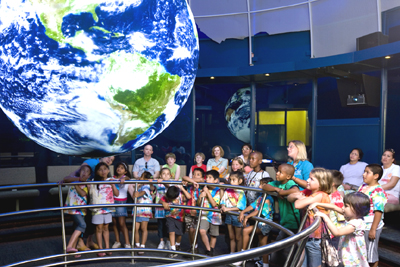When “Science on a Sphere” was unveiled at the South Florida Science Museum on Feb. 2, guests felt as if they stepped into a classroom with Leroy Jetson — straight out of the futuristic cartoon about his space-age family.
Developed by the National Oceanic and Atmospheric Association, “Science on a Sphere” is a 6-foot suspended globe displaying animated images of atmospheric storms, climate change, ocean temperature, animal migration patterns and more.
The exhibit is funded by a grant from Quantum Foundation and is one of the centerpieces of the museum’s expansion project.
Using computers and video projectors to display planetary data onto the globe’s surface, researchers at NOAA developed “Science on a Sphere” as an educational tool to help illustrate earth system science to people of all ages. Animated images explain sometimes complex environmental processes in a way that is simultaneously intuitive and captivating.
Imagine watching the nine-month trek of a juvenile loggerhead sea turtle as it swims from its release site. One of the “Science on a Sphere” data sets tells the story of Delta, an Atlantic sea turtle tracked from the Virginia Institute of Marine Science when she was rescued after being stranded in Deltaville, Va. After recovering from a broken left flipper and severe head injury, Delta was outfitted with a satellite tag, in order to track her movements and determine the success of her recovery. Immediately after release, Delta connected with the Gulf Stream and was transported north off of Nova Scotia and Newfoundland. Delta then appeared to wander around the Atlantic Ocean before turning back toward the United States. Delta was near Bermuda when the tag lost its battery power and stopped transmitting.
“You can imagine just how powerful this innovative technology will be to not only educate students and visitors but inspire guests to explore scientific career paths,” South Florida Science Museum CEO Lew Crampton said. “When children hear about Delta’s voyage and then learn about our own local sea turtle nesting season, we think more than a few of them will be inspired to continue a love of science and learning. We’re incredibly grateful to the Quantum Foundation for recognizing this unique instrument for teaching science, math and geography in a way that provides a dramatic visualization of complex information in an understandable form for the public. ‘Science on a Sphere’ offers a spectacular look at our world and at the universe. We know it’s going to be popular with museum visitors of all ages!”
Situated in a newly opened section of the museum’s expansion, the 200-pound fiberglass sphere will be suspended five feet off the ground. Four 3,000-lumen projectors and four personal computers synchronize and blend animated images from global environmental data sets. Images include the Earth’s topography, bathymetry, weather events, weather prediction models, and past and future climate change.
Viewers can watch 500 years of changing climate or travel back to the time when the Earth’s continents were one large land mass. They can see the sun erupting in spectacular solar storms. With a focus on hurricanes, Whirling Weather, a new educational demonstration, has since been developed for school groups. More than 300 data sets will be available to teach students of all ages.
“This unique exhibit is displayed in only two other museums in Florida, the Orlando Science Center and the United States Astronaut Hall of Fame Museum in Titusville,” said Kerry Diaz, president of Quantum Foundation. “Once installed, the South Florida Science Museum will house the only ‘Science on a Sphere’ in South Florida — another distinction that will set it apart from other science and nature centers. We are excited to be an integral part of the museum’s expansion progress.”
For more than 50 years, the South Florida Science Museum has offered an exceptional educational experience to more than 5 million students and visitors, and has succeeded as a growing and relevant public benefit organization in our community. Opening its doors in 1961, the museum was originally built to serve as an educational and cultural resource, and to further the understanding of science and technology within Palm Beach, Broward and Martin counties.
In addition to “Science on a Sphere,” the museum’s completed expansion is anticipated to open to the public in early June. The South Florida Science Museum is located at 4801 Dreher Trail North in West Palm Beach at the north end of Dreher Park. Admission is $11.95 for adults, $10.50 for seniors 62 and older, $8.95 for children ages 3 to 12, and free for children under 3 and museum members.
For more information about the South Florida Science Museum, call (561) 832-1988 or visit www.sfsm.org.
ABOVE: “Science on a Sphere” displays animated images of atmospheric storms, climate change, ocean temperature and more.








